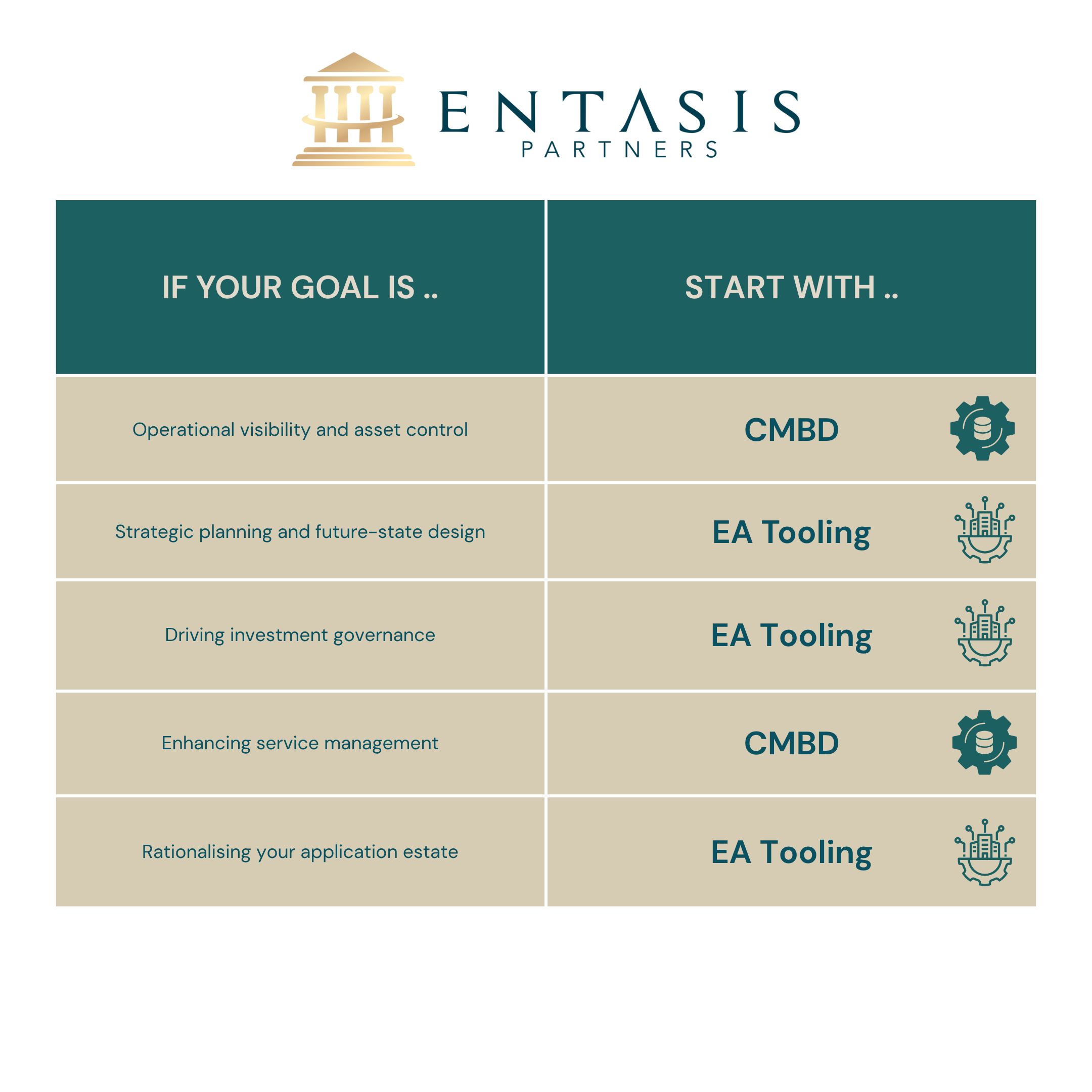". . One destination. Two very different starting points . ."
In recent conversations with Senior IT and Transformation Leaders, a common question has surfaced:
“We’re looking into CMDB and EA tooling, which should come first?”
It’s a good question, and the fact that so many are asking it highlights something important ..
Tools are only ever as effective as the organisation using them.
There’s no one-size-fits-all answer, but there are common patterns. The right choice depends on a mix of your current pain points, operating model, and crucially, your level of architectural maturity.
Understanding the difference
Let’s briefly define each:
- CMDB (Configuration Management Database)
A foundational component of IT service management (ITSM). CMDBs track the assets, systems, and relationships within your IT environment, helping IT operations maintain control, visibility, and compliance. - Enterprise Architecture (EA) Tools
Strategic platforms designed to support business and technology alignment. EA tooling maps applications, data, capabilities, and processes to enable decision-making, transformation planning, and investment governance.
Where Architecture maturity comes in
One of the most overlooked factors in this debate is your architecture maturity.
- If your EA function is still forming, lacks clear governance, or isn’t embedded in planning cycles, jumping into a heavy EA toolset can stall.
- If your IT estate is undocumented or operationally fragmented, introducing a CMDB without the right ownership can quickly become shelfware.
Before choosing a path, consider the following ..
- Do you have architects embedded across the business and IT?
- Is your organisation already using CMDB or asset discovery tools (even partially)?
- Are strategic technology decisions made with architectural input, or retrofitted?
This context is critical.
What problem are you trying to solve?

But remember, both can (and should) coexist eventually. The sequence depends on your starting point.
Pros and Cons of starting with CMDB
PROS
- Immediate visibility of infrastructure and dependencies
- Supports ITIL practices and incident/change management
- Quick operational impact if integrated well
CONS
- Relies on strong process discipline to stay accurate
- Doesn’t inform strategic direction or architectural value
- Can become a maintenance overhead without automation
Pros and Cons of starting with EA Tooling
PROS
- Aligns IT investments with business outcomes
- Enables planning for transformation and rationalisation
- Provides a strategic lens across capabilities, data, and tech
CONS
- Needs strong architectural leadership and stakeholder buy-in
- Slower time-to-value without foundational data
- Risk of underuse if not tied to governance
Our take at Entasis Partners
We’ve worked with organisations at all levels of maturity, from early-stage architectural capability to fully embedded design authorities. One pattern holds true:
You don’t need perfect data or fully mature architecture to start, but you do need to be honest about where you are.
In some environments, it makes sense to take a “CMDB-lite” approach first, get a working view of what’s live, align it to service management, and establish a baseline. From there, EA tooling becomes far more impactful.
In others, particularly where strategic planning is the bigger gap, it’s smarter to lead with EA tooling, even if some data needs to be stubbed out or imported later.
Ultimately, it’s not a tooling decision. It’s an intent and maturity decision.
Where do you start?
We help organisations navigate this exact challenge. We don’t lead with tools, we lead with outcomes, pragmatism, and architectural experience.
Whether you’re ..
- Struggling to get visibility of your estate
- Thinking about launching (or relaunching) an architecture function
- Trying to connect strategy, delivery, and transformation
.. Our team can help you make confident, staged decisions that actually land.
Need help deciding whether to start with CMDB or Enterprise Architecture Tooling?
Let’s have a conversation, no pressure, just perspective.






